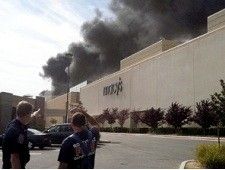'Emergency' Relieves Bureaucracy
By KATY GRIMES
Last Thursday a mentally ill young man walked into a mall in Placer County, and started a fire in a game store. He also told the store’s manager that he had a bomb in his backpack. Within hours, more than one-quarter of the mall had burned down or collapsed under the weight of the water used to fight the fire, and from the mall’s sprinklers.
By the next day, Gov. Arnold Schwarzenegger declared a State of Emergency in Placer County.
But many are scratching their heads and asking why the governor is assisting a privately-owned mall with taxpayer money. Or, if that’s not the purpose of the state’s emergency declaration, what is?
On Saturday, small business radio host Mark Montgomery had Congressman Tom McClintock, R-Rocklin, on as a guest. I called the radio show and asked McClintock why the governor would have made the emergency declaration for a mall in Placer County in McClintock’s district. McClintock also questioned the decision, and acknowledged that the privately-owned mall has insurance that will cover the damage.
For answers, Kelly Huston at the California office of Emergency Management was able to offer clarification.
Huston said, “The emergency declaration pays for things not covered by private insurance.”
To understand what this means, reading the governor’s declaration is helpful.
The first area of assistance is to the victims, and in this case, the mall employees, who will now find themselves unemployed. The declaration states, “…the provisions of Unemployment Insurance Code section 1253 imposing a one-week waiting period for unemployment insurance applicants are suspended as to all applicants who are unemployed as a direct result of the fire and damage to the regional shopping center in Placer County.”
Additionally, Huston said that anyone who lost a purse or wallet containing identification documents as a result of the mall evacuation, can get documents replaced quickly and at no charge by the DMV.
But the crux of the declaration, according to Huston, is to suspend the usual state-level bureaucracy that takes place during the cleanup, repair and rebuilding phases.
The emergency declaration reads, “...the statutes, rules, regulations and requirements are hereby suspended to the extent they apply to the following activities: (a) removal, storage, transportation and disposal of hazardous and non-hazardous debris resulting from the disaster; (b) necessary restoration; and (c) related activities.”
The California Environmental Protection Agency and the Secretary for the California Resources Agency were ordered by the governor to “use sound discretion in applying this suspension to ensure that the suspension serves the purpose of accelerating cleanup and recovery.”
Solid waste facility permits, waste discharge requirements for storage, disposal, and emergency construction activities, waste discharge requirements and/or Water Quality Certification, all have the usual permitting procedures suspended.
The governor’s emergency declaration appears to be for the purpose of getting state government out of the way of the recovery process.
Huston said, “Anything involving public infrastructure is also covered. If water pipelines were damaged, the state would reimburse the cost of repairs to the local government.”
Huston said that the state will reimburse the cost of the emergency responders, up to 75 percent. “Emergency responders are the largest cost,” said Huston. “Firefighters, investigators, police, all respond, and their local governments are struggling.”
According to Huston, without state of emergency declarations, local emergency responders could be hesitant to send local resources because of the cost to the local agencies. “They cannot pay for it,” said Huston.
“We are trying to reduce the amount of bureaucracy that slows down progress,” Huston added.
With an emergency declaration in place, state and local agencies can enter into contracts and arrange for the purchase of materials and necessary services, without the usual time-consuming procedures, in order to “quickly remove dangerous debris, repair damaged resources, and restore and protect the impacted area.”
The irony is that usual procedures are acknowledged to “prevent, hinder or delay.” The declarations states, “because strict compliance with the provisions of the Government Code and the Public Contract Code applicable to public agency contracts would prevent, hinder, or delay these efforts, applicable provisions of those statutes, including, but not limited to, advertising and competitive bidding requirements, are suspended to the extent necessary to address the effects of the fire.”
Contrast the massive state support of the mall fire with the state support offered to Placer County after the 49er fire in August 2009. Much shorter than the Placer County mall fire executive order, the governor ordered for the 49er fire, “all agencies of the state government utilize and employ state personnel, equipment and facilities for the performance of any and all activities consistent with the direction of the California Emergency Management Agency (CalEMA) and the State Emergency Plan, and that CalEMA provide local government assistance under the authority of the California Disaster Assistance Act.”
In his Proclamation of a State Emergency, the governor ordered the agencies to utilize personnel to help fight the fire. The order did not suspend the usual bureaucratic practices within the agencies in permitting, licensing or rebuilding.
The victims were also offered a waiver of the one-week waiting period for unemployment insurance, and Cal EPA statutes, rules, regulations and requirements were suspended during the recovery.
340 acres burned, 66 homes were destroyed, nine commercial businesses were destroyed or suffered major damage, and it took 355 emergency responder personnel to combat the fire in 2009.
The previous May, the governor issued an Executive Order ahead of fire season in the state, preparing for and readying CAL FIRE resources and personnel during the fire season. But neither order addressed, as comprehensively, the needs to rebuild business the way the latest emergency declaration has.
The latest emergency declarations appear to pave the way for reimbursements to local governments for the costs of police and fire crews responding to emergencies.
And locating the costs of these reimbursements within the state budget is not easy. CalWatchdog is still researching this information.
And yet, it was almost immediately reported that Roseville city officials said that the unburned sections of the mall could reopen within weeks, in time for the holiday shopping season.
As nearly all shopping malls are notorious for requiring exceptional insurance coverage by their shops and stores, with the top-of-the-line insurance policies about to kick in for the mall and store owners, people are still scratching their heads asking why a state of emergency was declared over a mall fire set by one mentally-disturbed young man in a game store.
Photo: Creative Commons
Related Articles
Top two primary intensifies anonymous online attacks
June 4, 2012 By John Hrabe Patricia McKeon is the prohibitive favorite to win the 38th State Assembly seat. As
CA green power keeps shifting costs to ratepayers
California Energy Markets recently reported that three California cities just won agreement from regulators to reclassify solar power transmission costs as distribution. The cities
CA bullet train crashes through federal, state safeguards
Jan. 28, 2013 By Chris Reed Reports that the California High-Speed Rail Authority and Amtrak are teaming up to buy




